
Norvasc side effects include swollen gums, bleeding gums, gingivitis and other symptoms of periodontal disease. Calcium channel blockers are known to cause pseudo pockets because they cause gingival hyperplasia. The periodontal charting suggests a need for active gum therapy except that the patient maintains excellent oral hygiene and she is taking Norvasc. The Periodontist found this patient to be stable and not to need further treatment. She was placed on a hygiene recall every three months and Periodontist exam once a year.
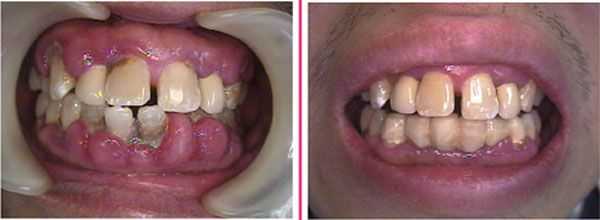
Medication in dentistry. This before and after photo shows the effect of using Calcium Channel blockers with inadequate periodontal maintenance – the gums and teeth weren’t clean before starting the medicine. Calcium Channel blockers are commonly used to treat high blood pressure, angina pectoris and coronary artery disease. Physicians should obtain periodontal clearance before prescribing such medication.
This dental fear phobia patient underwent two rounds of scaling & root planing, several teeth extractions and received a six teeth lower anterior temporary bridge. Photo #1 of 2.
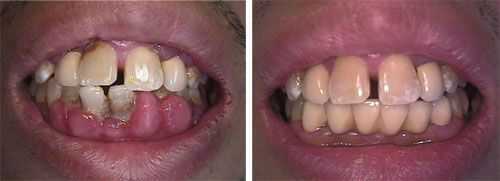
Before and After photos following Gum Disease Treatment and placement of final Porcelain Crowns on the lower front teeth are shown here. Photo #2 of 2.
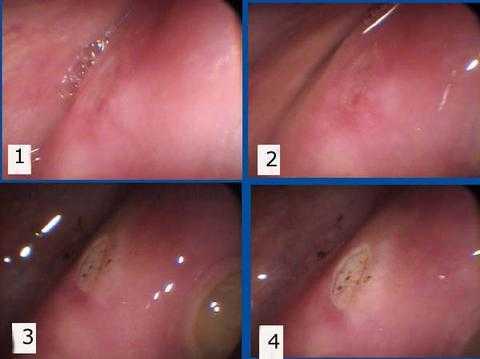
Medicine in Dentistry used to treat Canker Sore pain – Aphthous Ulcer. 1) and 2) Before pictures show inside the cheek. 3) and 4) After pictures show the chemical burn induced by sulfuric acid and sulfonated phenols in an aqueous solution. This treatment eliminates canker sore pain in seconds! This medication is only sold to dentists and physicians for in-office use.

Medication in Dentistry – Mineral Trioxide Aggregate used in the treatment of Internal Resorption for an upper left lateral incisor tooth #10. 1) Pre-op x-ray 11/15/2000. Patient had a history of falling off a horse. 2) Post-op xray taken 2/22/2001. #40 file used with NAOCL but #30 file used to apex. MTA – mineral trioxide aggregate was placed. 3) Radiograph reevaluation 7/7/2004. Resorption appears stable.
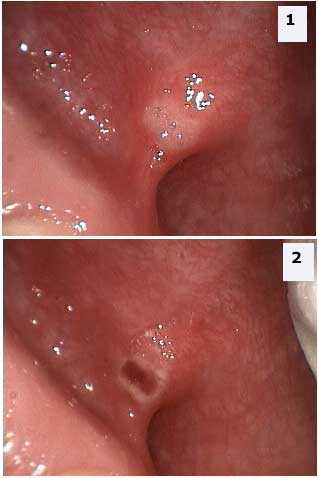
Dental Medicine – Application of Sulfuric Acid and Sulfonated Phenolics in an aqueous solution for treatment of a canker sore. This is a chemical cautery agent that specifically adheres to apthous tissue. The medicine actually burns the skin and thereby quickly creates a comfortable scab without the canker sore pain. 1) Photo of the canker sore. 2) Photo taken after application of this solution. The procedure is painless, takes only five minutes and does not even require anesthesia. Patients feel nearly immediate relief from the aphthous ulcer pain canker sore that otherwise would have lasted for seven to ten days. This treatment does not prevent the recurrence of the aphthous ulcer.
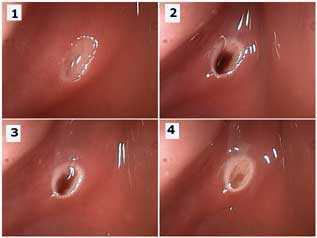
In-office application of a medicine for the treatment of an aphthous ulcer pain – canker sore. How to Pictures. 1) The initial canker sore. 2) Application of Sulfuric Acid and Sulfonated Phenolics in an aqueous solution with a small bonding brush. This chemical cautery agent that specifically adheres to apthous tissue is only sold to dentists and doctors for in-office use. The medicine actually burns the skin and thereby quickly creates a comfortable scab without the canker sore pain. 3) One minute later. 4) Two minutes later. The painful canker sore is almost completely gone in minutes. For more information, click on the “Dental Articles” at the top of this page and then click on “Canker Sores” in the left margin.
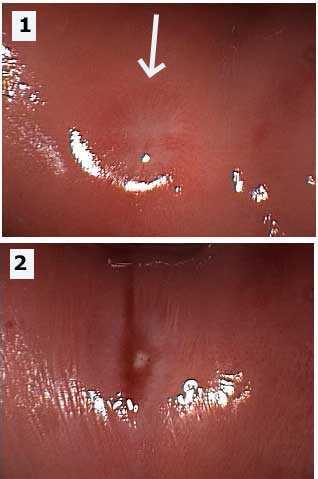
Medication treatment of canker sore pain. How to Pictures 1) The initial canker sore. 2) Immediately after application of Sulfuric Acid and Sulfonated Phenolics in an aqueous solution with a small bonding brush. This is a chemical cautery agent that specifically adheres to apthous tissue. The pain associated with the canker sore is almost completely gone in minutes. For more information, click on the “Dental Articles” at the top of this page and then click on “Canker Sores” in the left margin. Canker Sores are Aphthous Ulcers.